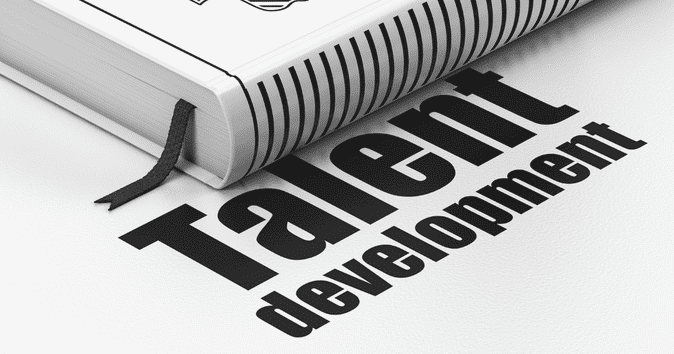Talent Development: Strategies to Future Proof Your Workforce

A comprehensive study by LinkedinOpens in a new tab showed that 94% of employees were willing to stay with a company that offers them talent development programs.
This applies to new hires, but what about upper management within your talent marketplace? Do they need development as well? Actually, they do. And surprisingly, only 35% of companies have established programs for succession planningOpens in a new tab.
Read on to learn what talent development is, why it’s important, the main goals, and how HR teams can achieve them.
What is talent development?
Strong talent development is a part of the human resource department’s responsibilities. It is simply the acquisition, retention, and training of talented candidates at all levels. It’s selecting the cream of the crop and making them even better.
Why talent development became important
Back in the day, onboarding new employees took less than a week. And mentoring middle management was done over business lunches and on the job. This is not the case in today’s realities...
Challenges in the workplace have been changed.
New tech, working remotely, and hugely impactful events like a pandemic are changing the rules of the game. Additionally, defacto practices in finance, crypto everything, artificial intelligence, and blockchain call for very different skill sets than those needed just five years ago.
That’s why companies are now setting up programs to develop the knowledge base and provide extra training for the best talent. The opportunity to learn new-age information and in-demand skills is highly coveted. And many applicants rush to companies with such programs.
Up-skilling middle management comes with another set of challenges. They must become familiar with the new tech and set up suitable training programs for new hires. Naturally, the whole corporate culture and several operations also need to change.
The price of talent development: A cost-benefit analysis
Many companies compare the price of buying talent with the price of building talent. Return on investment is always on everyone’s mind, and employers want to be reassured that they’ve spent their money wisely.

According to a 2020 state of the industry reportOpens in a new tab that surveyed 283 organizations, training new employees costs around $1308, and on average, an employee gets 34.7 hours of formal training per year. Formal training includes 1-on-1 instruction, delivery of e-content material, and live facilitated instruction but does not include informal learning that employees might receive from doing their work.
The benefits are worth it and many companies found that individually tailored training programs attracted the best candidates. On top of that, these employees often stayed longer in the company and showed double the engagement of regular employees.
These talented folks observably increased customer satisfaction and contributed significantly to the company's success. It’s a win-win situation.
Talent development vs. talent management
Talent development goes hand-in-hand with talent management most of the time. They both aim to encourage the highest performers to join the workforce, and both programs are focused on increasing the company’s productivity.
Despite the overlap and similarities, some fundamental differences set talent development and talent management apart.
Talent development is a case-by-case process that addresses the strengths and weaknesses of high-potential individuals. The HR department, along with relevant supervisors, guides these candidates to the best career path. They get suitable training, engaging tasks, and one-on-one mentoring.
On the other hand, talent managementOpens in a new tab focuses on attracting talented individuals. And once they’re hired, this program provides the necessary incentives to keep them on board. It’s more of a big-picture approach that doesn’t get into the nitty gritty of individual needs.
Talent development model and process
Typically, talent development starts with assigning a talent development officer to get this operation off the ground.
- The first step in this process is stating the short and long-term organizational goals.
- Next, the officer needs to list the required skills to achieve these goals.
- A company-wide search for talent and an invitation for new hires are started.
- Once the candidates are all set, the personalized training programs begin
This is not a one-off short program that ends in a couple of weeks. Talent development is an ongoing process of continuing education, on-the-job training, and reassessment.
Why should organizations prioritize talent development?

Many of the biggest organizations across the globe are prioritizing talent development programs. This is to the extent that Forbes magazine labeled the talent development officers as the most important persons in the company.
Talented and highly skilled employees boost any company’s overall performance on all levels. Employee productivity increases significantly, resulting in bigger gains and better growth opportunities.
Here are some good reasons why talent development became strategically essential.
- Attracting top talent
- Increasing employee productivity
- Boosting engagement
- Decreasing employee turnover
- Solving difficult problems
- Sorting out succession planning
- Increasing corporate capital
- Accelerating corporate growth
- Compliance with legal requirements
Why promoting DE&I must be part of your talent development plan
Compliance with the requirements for DE&I is essential for all businesses. This is to ensure that no employee is left behind and no talent goes unnoticed.
Additionally, diversity, equity, and inclusion are important values for Millennials and GenZ. They prefer working for companies that consider these core values. Considering the fact that these workers constitute a significant chunk of the skilled workforce, then this is a matter that needs attention.
Talent development examples
The details of actually developing top talent differ from one company to the next. That’s because corporate goals and skill sets vary widely. Some basic approaches are:
- Interactive learning
- Shadowing senior staff
- Personalized mentoring
- Online learning
- Training at third-party premises
- Supervised tasks and projects
Statistics on talent development
A recent studyOpens in a new tab showed that almost 60% of employees would need re-training to be able to do their jobs in the near future. This means that basic training plus specialized training for promising candidates is a must.
At the same time, surveysOpens in a new tab revealed that 40% of employees are considering leaving their current job at any given moment.
This contrasts sharply with the fact that 90% of employees are attracted to companies that offer talent development initiatives, and they’re more likely to stay there.
Five strategies to improve talent development

The following five strategies are considered the best ways to improve talent development. You can, of course, change some details to suit your company’s culture, requirements, and goals.
1. Align your program with the corporate goals
Companies routinely formulate strategies. They do this every 3-5 years, in addition to revisiting the strategies when major events are happening or before taking big steps like acquisitions, expansion, or diversification.
Sometimes, top management and other stakeholders are deterred from expanding their operations due to the lack of trained personnel. That would be a great time to propose an ambitious talent development program.
Getting the C-suite to approve your plans would be a breeze if it aligns with the company’s short and long-term goals.
2. Assess your in-house talent accurately
Many of your current employees would jump at the opportunity of learning new skills and advancing their careers. Some have real potential and would be an addition to your program.
You can conduct corporate-wide surveys, competitions, and reviews to comb the various teams for promising candidates. It’s also effective to use talent intelligence analytics to identify individuals with strong potential, while talking to the people around you to assess who has the best soft skills.
3. Put incentives to acquire and retain talent
In-house employees are rarely enough to get a major undertaking off the ground. Hiring talent is inevitable, so make sure to attract the best in the market. Ask yourself the question; why would an employee choose your company rather than the competition?
The answer lies in what you have to offer. This includes tangibles, like financial incentives, in addition to non-tangibles, like company culture.
4. Recruit the right trainers
You can assign an in-house team of experts, professionals, top managers, and middle managers to mentor the selected candidates.
Additionally, you can solicit the services of a third party to handle the training, up-skilling, and re-skilling processes required for talent development.
5. Implement, evaluate, and adjust
Implementing a strategy should be done in sequential steps and phases. It’s best to draft detailed plans and make all the stakeholders aware of the what, when, and how. Performance management is critical at this initial stage.
Monitor all outcomes faithfully. Measure the KPIs that would help you assess your strategy's success and effectiveness.
Strategies are never written in stone. You’d need to make changes constantly based on how things play out. There are always lessons learned and better ways to do any job.
FAQ
What does a talent development person do?
The talent development specialist works with all the different levels of the company. The process starts with drafting a needs assessment document. Then, moves on to selecting the right candidates and polishing their talents to brilliance.
What is the difference between skill development and talent development?
Skill development means getting better at a certain job. On the other hand, talent development means improving various aspects of an individual, including soft skills. This often focuses on closing skill gaps.
How can I discover my talent?
There are many ways to uncover hidden employee potential. The easiest is taking an online aptitude test. Other methods include remembering which activities you liked most as a child and what comes to you easily.
If you struggle to play the piano and do the math for fun, that should point you towards technical interests rather than artistic ones.
Conclusion
Effective talent development has recently become an essential part of corporate strategy. It attracts the best employees like a magnet and once hired, they rarely leave.
Additionally, companies that focus on improving their talented workers usually get outstanding results in terms of short-term gains and opportunities for growth.
With a continuous performance management platform like Conversations® from Workhuman, managers can keep their employees' development top of mind. Learn more today!
About the author
Ryan Stoltz
Ryan is a search marketing manager and content strategist at Workhuman where he writes on the next evolution of the workplace. Outside of the workplace, he's a diehard 49ers fan, comedy junkie, and has trouble avoiding sweets on a nightly basis.